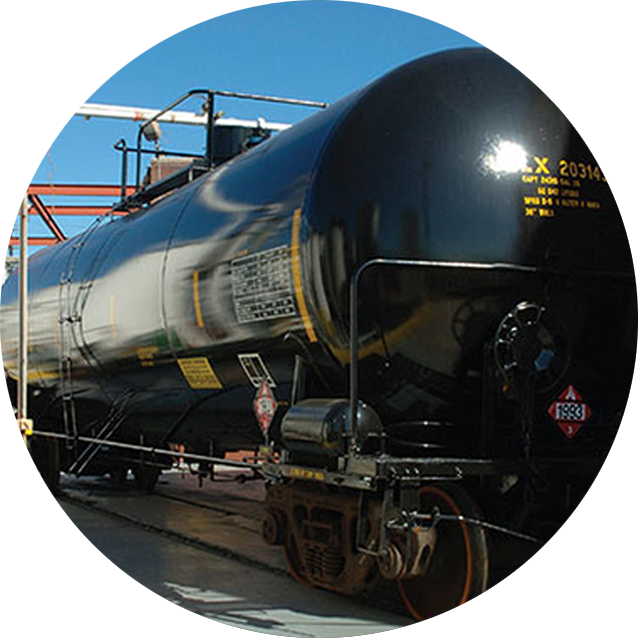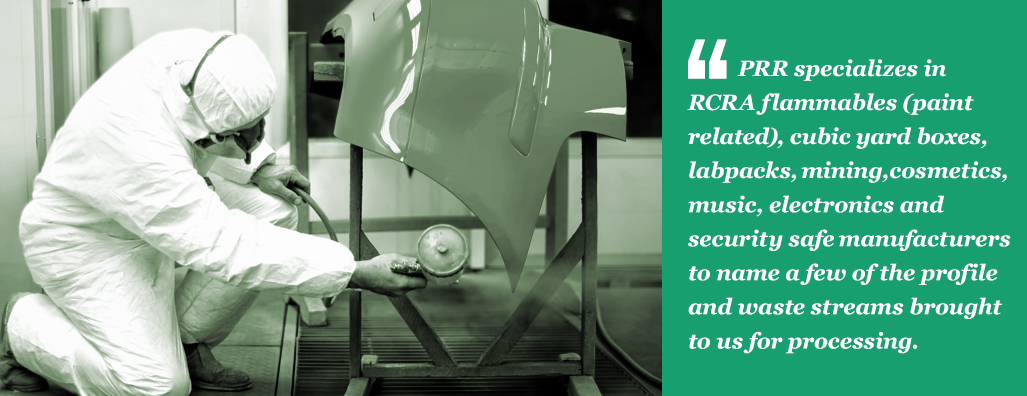One of California’s best licensed TSD Facility that’s right on track.
Since 1980, The System has grown from a Full Service Solvent Provider to PRR's complete Treatment, Storage, and Disposal Facility (TSDF) that processes and handles a myriad of industrial waste streams. With a combined staff experience that exceeds over a century, its the commitment of our people that keeps PRR and our clients safe and compliant. In fact during our site audits, regulator agents often compliment us for our clean and efficient facility.
Over the years PRR has helped many clients in training and waste minimization. When the new waterborne coating technology was developed, we were the first to create a waterborne cleaning solution for the paint industry. Today, we continue to research and provide the safest, most compliant and eminently competitive solutions for our refinishing and manufacturing partners.
Converting waste to energy.
In the past, dirty solvents ended up in our landfills rotting in rusted drums or was even poured down drains. Around the late 1970’s, the Berg family began blending and converting alternative fuels, reducing oil consumption and also eliminating these wastes from entering our earth or waterways. While decreasing the impact on the environment, our company was able to transform waste-to-energy. Today this newly created fuel through our process is used to fire cement kilns, which are needed in the production of Portland and other varieties of cements. Nearly 20 cement kilns across the country use regulated waste as a supplemental fuel and 60% of the cost of manufacturing cement is in the fossil fuels needed to produce temperatures of over 3000˚ F.
The waste types we welcome.
WASTE TYPES AND CALIFORNIA WASTE CODES HANDLED BY PRR:
For more information about PRR Waste Services, please call (800) 499-7145
CODE |
DESCRIPTION |
|---|---|
| 131 | Aqueous solution |
| 132 | Aqueous solution with metals |
| 133 | Aqueous solution with total organic residues 10% or more |
| 134 | Aqueous solution with total organic residues <10% |
| 135 | Unspecific aqueous solution |
| 141 | Off-specification, aged, or surplus inorganics |
| 181 | Other inorganic solid waste |
| 211 | Halogenated solvents (chloroform, methyl chloride, perchloroethylene, etc.) |
| 212 | Oxygenated solvents (acetone, butanol, ethyl acetate, etc.) |
| 213 | Hydrocarbon solvents (benzene, hexane, Stoddard, etc.) |
| 214 | Unspecified solvent mixture |
| 221 | Waste oil and mixed oil |
| 223 | Unspecified oil-containing waste |
| 252 | Other still bottom waste |
| 281 | Adhesives |
| 291 | Latex waste |
| 331 | Off-specification, aged, or surplus organics |
| 341 | Organic liquids (non-solvents) with halogens |
| 342 | Organic liquids with metals |
| 343 | Unspecified organic liquid mixture |
| 351 | Organic solids with halogens |
| 352 | Other organic solids |
| 461 | Paint sludge |
| 491 | Unspecified sludge waste |
| 512 | Other empty containers 30 gallons or more |
| 513 | Empty containers less than 30 gallons |
| 551 | Laboratory waste chemicals |
| 612 | Household wastes |
| 722 | Liquids with cadmium |
| 723 | Liquids with chromium |
| 724 | Liquids with lead |
| 725 | Liquids with mercury |
| 726 | Liquids with nickel |
| 727 | Liquids with selenium |
| 728 | Liquids with thalium |
| 741 | Liquids with halogenated organic compounds |
| 751 | Solids or sludges with halogenated organic compounds |
EPA Waste ID |
WASTE TYPE |
COMMENTS |
|---|---|---|
| D001 | Ignitable | Ignitable |
| D005 | Barium | Toxic |
| D006 | Cadmium | Toxic |
| D007 | Chromium | Toxic |
| D008 | Lead | Toxic |
| D009 | Mercury | Toxic |
| D010 | Selenium | Toxic |
| D011 | Silver | Toxic |
| D018 | Benzene | Toxic |
| D021 | Chlorobenzene | Toxic |
| D022 | Chloroform | Toxic |
| D023 | o-Cresol | Toxic |
| D024 | m-Cresol | Toxic |
| D025 | p-Cresol | Toxic |
| D026 | Cresol | Toxic |
| D035 | Methyl Ethyl Ketone | Toxic |
| D039 | Tetrachloroethylene | Toxic |
| D040 | Trichloroethylene | Toxic |
| F001 | The following spent halogenated solvents used in degreasing: Tetrachloroethylene, methylene chloride, 1,1,1-trichloroethane, carbon tetrachloride, and chlorinated fluorocarbons; all spent solvent mixture/blends used in degreasing containing, before use, a total of ten percent or more (by volume) of one or more of the above halogenated solvents or those solvents listed in F002, F004 and F005; and still bottoms from the recovery of these spent solvents and volumes of one or more of the above halogenated solvents or those solvents listed in F002, F004 and F005; and still bottoms from the recovery of these spent solvents and spent solvent mixtures. | Toxic |
| F002 | The following spent halogenated solvents: Tetrachloroethylene, methylene chloride, trichloroethylene, 1,1,1-trichloroethane, chlorobenzene, 1,1,2-trichloroethane, 1,2,2-trifluoroethane, orthodichloro benzene, trichlorofluoromethane, and 1,1,2-trichloroethane; all spent solvent mixture/blends containing, before use, a total of ten percent or more (by volume) of one or more of the above halogenated solvents or those listed in F001, F004 or F005; and still bottoms from the recovery of these spent solvents and spent solvent mixtures. | Toxic |
| F003 | The following spent non-halogenated solvents: Xylene, acetone, ethyl acetate, ethyl benzene, ethyl ether, methyl isobutyl ketone, n-butyl alcohol, cyclohexanone, and methanol; all spent solvent mixtures/blends containing, before use, only the above spent non-halogenated solvents; and all spent solvent mixtures/blends containing, before use, one or more (by volume) or one or more of those solvents listed in F001, F002, F004, and F005; and still bottoms from the recovery of these spent solvents and spent solvent mixtures. | Ignitable/Toxic |
| F005 | The following spent non-halogenated solvents: Toluene, methyl ethyl ketone, carbon disulfide, isobutanol, pyridine, benzene, 2-ethoxyethanol, 2-nitropropane; all spent solvent mixture/blends containing, before use, a total of ten percent or more of the above non-halogenated solvents or those solvents listed in F001, F002 or F004; and still bottoms from the recovery of these spent solvent mixtures. | Ignitable/Toxic |
| K086 | Ink formulation, solvent washes and sludges, caustic washes and sludges, or water washes and sludges from cleaning tubs and equipment used in the formulation of ink from pigments, driers, soaps, and stabilizers containing chromium and lead. | Toxic |
| U002 | Acetone | Ignitable |
| U031 | Butyl Alcohol | Ignitable |
| U037 | Chlorobenzene | Ignitable |
| U056 | Chlorohexane | Ignitable |
| U057 | Chlorohexanone | Ignitable |
| U080 | Dichloromethane (Methylene Chloride) | Toxic |
| U112 | Ethyl Acetate | Ignitable |
| U140 | Isobutyl Alcohol | Ignitable/toxic |
| U154 | Methyl Alcohol | Ignitable |
| U159 | Methyl Ethyl Ketone (MEK) | Ignitable/toxic |
| U161 | 4-Methyl-2-Pentanone | Ignitable |
| U210 | Tetrachloroethylene | Toxic |
| U213 | Tetrahydrofuran | Ignitable |
| U220 | Toluene | Ignitable/toxic |
| U226 | 1,1,1-Trichloroethane | Toxic |
| U227 | 1,1,2-Trichloroethane | Toxic |
| U228 | Trichloroethane | Toxic |
| U239 | Xylene | Ignitable/toxic |



